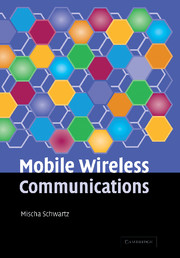Book contents
- Frontmatter
- Contents
- Preface
- 1 Introduction and overview
- 2 Characteristics of the mobile radio environment–propagation phenomena
- 3 Cellular concept and channel allocation
- 4 Dynamic channel allocation and power control
- 5 Modulation techniques
- 6 Multiple access techniques: FDMA, TDMA, CDMA; system capacity comparisons
- 7 Coding for error detection and correction
- 8 Second-generation, digital, wireless systems
- 9 Performance analysis: admission control and handoffs
- 10 2.5G/3G Mobile wireless systems: packet-switched data
- 11 Access and scheduling techniques in cellular systems
- 12 Wireless LANs and personal-area networks
- References
- Index
5 - Modulation techniques
Published online by Cambridge University Press: 05 June 2012
- Frontmatter
- Contents
- Preface
- 1 Introduction and overview
- 2 Characteristics of the mobile radio environment–propagation phenomena
- 3 Cellular concept and channel allocation
- 4 Dynamic channel allocation and power control
- 5 Modulation techniques
- 6 Multiple access techniques: FDMA, TDMA, CDMA; system capacity comparisons
- 7 Coding for error detection and correction
- 8 Second-generation, digital, wireless systems
- 9 Performance analysis: admission control and handoffs
- 10 2.5G/3G Mobile wireless systems: packet-switched data
- 11 Access and scheduling techniques in cellular systems
- 12 Wireless LANs and personal-area networks
- References
- Index
Summary
We have stressed thus far in this book basic system concepts in mobile cellular systems. We have discussed the propagation environment and modeling thereof, the use of geographically assigned cells to increase capacity by channel reuse, and, finally, in the last chapter, the use of dynamic channel allocation and power control to improve system performance. Implicit in all of this was the assumption that users communicate over assigned channels. Depending on the system under study, a channel can be a frequency band, a time slot in a frequency band, or a unique code, a sequence of defined binary symbols. In each of these cases, communication is carried out using a specified carrier frequency, with various modulation techniques used to transmit the desired information, whether it be voice, data, or other types of information-bearing signals, over this carrier. In this chapter we describe various modulation techniques proposed or adopted to utilize the channels most effectively.
Modulation or variation of the frequency of a carrier is universally used in communication systems to bring the information to be transmitted up to a desired operating or carrier frequency. In the case of mobile wireless systems, the resultant modulated radio signal is then transmitted uplink, from mobile to base station, or downlink, from base station to mobile, as the case may be. The transmitted power discussed in previous chapters was the power in this modulated carrier signal.
- Type
- Chapter
- Information
- Mobile Wireless Communications , pp. 107 - 136Publisher: Cambridge University PressPrint publication year: 2004

